on an initially uncharged capacitor C , charged through a resistance R
temperature increase of the resistor, given that its mass is 2.50 g and its
?
specific heat is 1.67
kJ
68. A 500-Ω resistor, an uncharged 1.50-μF capacitor, and a 6.16-V
kg ⋅ ºC , noting that most of the thermal energy is
emf are connected in series. (a) What is the initial current? (b) What is
retained in the short time of the discharge. (c) Calculate the new
the RC time constant? (c) What is the current after one time constant?
resistance, assuming it is pure carbon. (d) Does this change in resistance
(d) What is the voltage on the capacitor after one time constant?
seem significant?
77. Unreasonable Results
69. A heart defibrillator being used on a patient has an RC time
constant of 10.0 ms due to the resistance of the patient and the
(a) Calculate the capacitance needed to get an RC time constant of
capacitance of the defibrillator. (a) If the defibrillator has an 8.00-μF
1.00×103 s with a 0.100-Ω resistor. (b) What is unreasonable about
capacitance, what is the resistance of the path through the patient? (You
this result? (c) Which assumptions are responsible?
may neglect the capacitance of the patient and the resistance of the
78. Construct Your Own Problem
defibrillator.) (b) If the initial voltage is 12.0 kV, how long does it take to
decline to 6.00×102 V ?
Consider a camera’s flash unit. Construct a problem in which you
calculate the size of the capacitor that stores energy for the flash lamp.
70. An ECG monitor must have an RC time constant less than
Among the things to be considered are the voltage applied to the
capacitor, the energy needed in the flash and the associated charge
1.00×102 μs to be able to measure variations in voltage over small
needed on the capacitor, the resistance of the flash lamp during
time intervals. (a) If the resistance of the circuit (due mostly to that of the
discharge, and the desired RC time constant.
patient’s chest) is 1.00 kΩ , what is the maximum capacitance of the
79. Construct Your Own Problem
circuit? (b) Would it be difficult in practice to limit the capacitance to less
than the value found in (a)?
Consider a rechargeable lithium cell that is to be used to power a
camcorder. Construct a problem in which you calculate the internal
71. Figure 21.55 shows how a bleeder resistor is used to discharge a
resistance of the cell during normal operation. Also, calculate the
capacitor after an electronic device is shut off, allowing a person to work
minimum voltage output of a battery charger to be used to recharge your
on the electronics with less risk of shock. (a) What is the time constant?
lithium cell. Among the things to be considered are the emf and useful
(b) How long will it take to reduce the voltage on the capacitor to 0.250%
terminal voltage of a lithium cell and the current it should be able to
(5% of 5%) of its full value once discharge begins? (c) If the capacitor is
supply to a camcorder.
charged to a voltage V 0 through a 100-Ω resistance, calculate the
time it takes to rise to 0.865 V 0 (This is about two time constants.)
Figure 21.55
72. Using the exact exponential treatment, find how much time is
required to discharge a 250-μF capacitor through a 500-Ω resistor
down to 1.00% of its original voltage.
73. Using the exact exponential treatment, find how much time is
required to charge an initially uncharged 100-pF capacitor through a
75.0-M Ω resistor to 90.0% of its final voltage.
74. Integrated Concepts
If you wish to take a picture of a bullet traveling at 500 m/s, then a very
brief flash of light produced by an RC discharge through a flash tube
can limit blurring. Assuming 1.00 mm of motion during one RC constant
is acceptable, and given that the flash is driven by a 600-μF capacitor,
what is the resistance in the flash tube?
75. Integrated Concepts

CHAPTER 22 | MAGNETISM 773
22
MAGNETISM
Figure 22.1 The magnificent spectacle of the Aurora Borealis, or northern lights, glows in the northern sky above Bear Lake near Eielson Air Force Base, Alaska. Shaped by
the Earth’s magnetic field, this light is produced by radiation spewed from solar storms. (credit: Senior Airman Joshua Strang, via Flickr)
Learning Objectives
22.1. Magnets
• Describe the difference between the north and south poles of a magnet.
• Describe how magnetic poles interact with each other.
22.2. Ferromagnets and Electromagnets
• Define ferromagnet.
• Describe the role of magnetic domains in magnetization.
• Explain the significance of the Curie temperature.
• Describe the relationship between electricity and magnetism.
22.3. Magnetic Fields and Magnetic Field Lines
• Define magnetic field and describe the magnetic field lines of various magnetic fields.
22.4. Magnetic Field Strength: Force on a Moving Charge in a Magnetic Field
• Describe the effects of magnetic fields on moving charges.
• Use the right hand rule 1 to determine the velocity of a charge, the direction of the magnetic field, and the direction of the magnetic force
on a moving charge.
• Calculate the magnetic force on a moving charge.
22.5. Force on a Moving Charge in a Magnetic Field: Examples and Applications
• Describe the effects of a magnetic field on a moving charge.
• Calculate the radius of curvature of the path of a charge that is moving in a magnetic field.
22.6. The Hall Effect
• Describe the Hall effect.
• Calculate the Hall emf across a current-carrying conductor.
22.7. Magnetic Force on a Current-Carrying Conductor
• Describe the effects of a magnetic force on a current-carrying conductor.
• Calculate the magnetic force on a current-carrying conductor.
22.8. Torque on a Current Loop: Motors and Meters
• Describe how motors and meters work in terms of torque on a current loop.
• Calculate the torque on a current-carrying loop in a magnetic field.
22.9. Magnetic Fields Produced by Currents: Ampere’s Law
• Calculate current that produces a magnetic field.
• Use the right hand rule 2 to determine the direction of current or the direction of magnetic field loops.
22.10. Magnetic Force between Two Parallel Conductors
• Describe the effects of the magnetic force between two conductors.
• Calculate the force between two parallel conductors.
22.11. More Applications of Magnetism
• Describe some applications of magnetism.

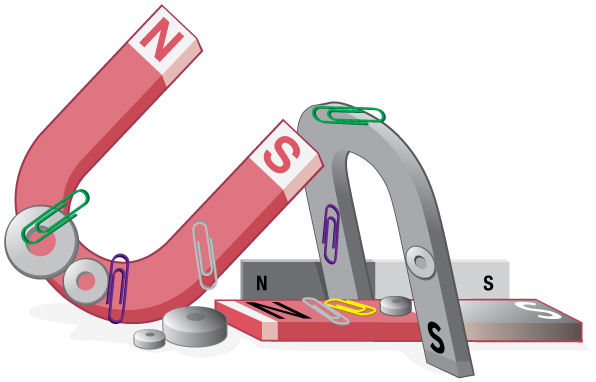
774 CHAPTER 22 | MAGNETISM
Introduction to Magnetism
One evening, an Alaskan sticks a note to his refrigerator with a small magnet. Through the kitchen window, the Aurora Borealis glows in the night sky.
This grand spectacle is shaped by the same force that holds the note to the refrigerator.
People have been aware of magnets and magnetism for thousands of years. The earliest records date to well before the time of Christ, particularly in
a region of Asia Minor called Magnesia (the name of this region is the source of words like magnetic). Magnetic rocks found in Magnesia, which is
now part of western Turkey, stimulated interest during ancient times. A practical application for magnets was found later, when they were employed
as navigational compasses. The use of magnets in compasses resulted not only in improved long-distance sailing, but also in the names of “north”
and “south” being given to the two types of magnetic poles.
Today magnetism plays many important roles in our lives. Physicists’ understanding of magnetism has enabled the development of technologies that
affect our everyday lives. The iPod in your purse or backpack, for example, wouldn’t have been possible without the applications of magnetism and
electricity on a small scale.
The discovery that weak changes in a magnetic field in a thin film of iron and chromium could bring about much larger changes in electrical
resistance was one of the first large successes of nanotechnology. The 2007 Nobel Prize in Physics went to Albert Fert from France and Peter
Grunberg from Germany for this discovery of giant magnetoresistance and its applications to computer memory.
All electric motors, with uses as diverse as powering refrigerators, starting cars, and moving elevators, contain magnets. Generators, whether
producing hydroelectric power or running bicycle lights, use magnetic fields. Recycling facilities employ magnets to separate iron from other refuse.
Hundreds of millions of dollars are spent annually on magnetic containment of fusion as a future energy source. Magnetic resonance imaging (MRI)
has become an important diagnostic tool in the field of medicine, and the use of magnetism to explore brain activity is a subject of contemporary
research and development. The list of applications also includes computer hard drives, tape recording, detection of inhaled asbestos, and levitation of
high-speed trains. Magnetism is used to explain atomic energy levels, cosmic rays, and charged particles trapped in the Van Allen belts. Once again,
we will find all these disparate phenomena are linked by a small number of underlying physical principles.
Figure 22.2 Engineering of technology like iPods would not be possible without a deep understanding magnetism. (credit: Jesse! S?, Flickr)
22.1 Magnets
Figure 22.3 Magnets come in various shapes, sizes, and strengths. All have both a north pole and a south pole. There is never an isolated pole (a monopole).
All magnets attract iron, such as that in a refrigerator door. However, magnets may attract or repel other magnets. Experimentation shows that all
magnets have two poles. If freely suspended, one pole will point toward the north. The two poles are thus named the north magnetic pole and the
south magnetic pole (or more properly, north-seeking and south-seeking poles, for the attractions in those directions).
Universal Characteristics of Magnets and Magnetic Poles
It is a universal characteristic of all magnets that like poles repel and unlike poles attract. (Note the similarity with electrostatics: unlike charges
attract and like charges repel.)
Further experimentation shows that it is impossible to separate north and south poles in the manner that + and − charges can be separated.
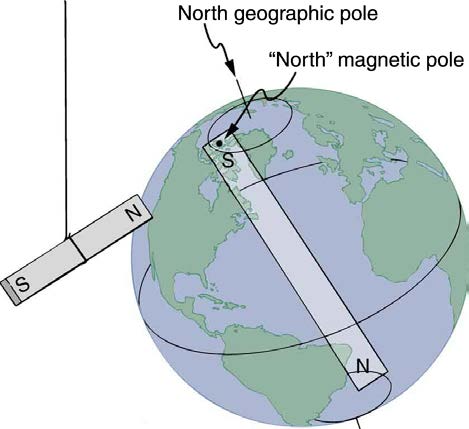
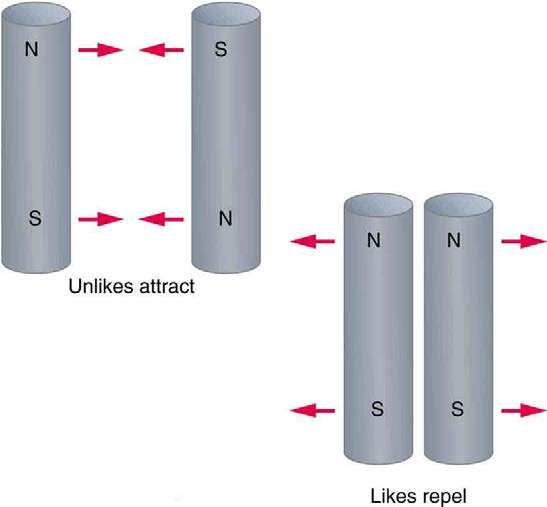
CHAPTER 22 | MAGNETISM 775
Figure 22.4 One end of a bar magnet is suspended from a thread that points toward north. The magnet’s two poles are labeled N and S for north-seeking and south-seeking
poles, respectively.
Misconception Alert: Earth’s Geographic North Pole Hides an S
The Earth acts like a very large bar magnet with its south-seeking pole near the geographic North Pole. That is why the north pole of your
compass is attracted toward the geographic north pole of the Earth—because the magnetic pole that is near the geographic North Pole is
actually a south magnetic pole! Confusion arises because the geographic term “North Pole” has come to be used (incorrectly) for the magnetic
pole that is near the North Pole. Thus, “North magnetic pole” is actually a misnomer—it should be called the South magnetic pole.
Figure 22.5 Unlike poles attract, whereas like poles repel.
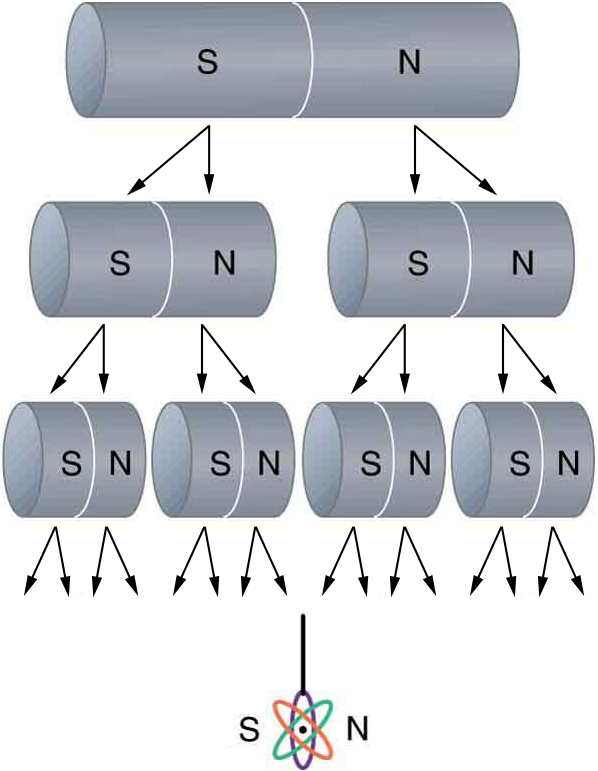

776 CHAPTER 22 | MAGNETISM
Figure 22.6 North and south poles always occur in pairs. Attempts to separate them result in more pairs of poles. If we continue to split the magnet, we will eventually get
down to an iron atom with a north pole and a south pole—these, too, cannot be separated.
The fact that magnetic poles always occur in pairs of north and south is true from the very large scale—for example, sunspots always occur in pairs
that are north and south magnetic poles—all the way down to the very small scale. Magnetic atoms have both a north pole and a south pole, as do
many types of subatomic particles, such as electrons, protons, and neutrons.
Making Connections: Take-Home Experiment—Refrigerator Magnets
We know that like magnetic poles repel and unlike poles attract. See if you can show this for two refrigerator magnets. Will the magnets stick if
you turn them over? Why do they stick to the door anyway? What can you say about the magnetic properties of the door next to the magnet? Do
refrigerator magnets stick to metal or plastic spoons? Do they stick to all types of metal?
22.2 Ferromagnets and Electromagnets
Ferromagnets
Only certain materials, such as iron, cobalt, nickel, and gadolinium, exhibit strong magnetic effects. Such materials are called ferromagnetic, after
the Latin word for iron, ferrum. A group of materials made from the alloys of the rare earth elements are also used as strong and permanent magnets;
a popular one is neodymium. Other materials exhibit weak magnetic effects, which are detectable only with sensitive instruments. Not only do
ferromagnetic materials respond strongly to magnets (the way iron is attracted to magnets), they can also be magnetized themselves—that is, they
can be induced to be magnetic or made into permanent magnets.
Figure 22.7 An unmagnetized piece of iron is placed between two magnets, heated, and then cooled, or simply tapped when cold. The iron becomes a permanent magnet with
the poles aligned as shown: its south pole is adjacent to the north pole of the original magnet, and its north pole is adjacent to the south pole of the original magnet. Note that
there are attractive forces between the magnets.
When a magnet is brought near a previously unmagnetized ferromagnetic material, it causes local magnetization of the material with unlike poles
closest, as in Figure 22.7. (This results in the attraction of the previously unmagnetized material to the magnet.) What happens on a microscopic
scale is illustrated in Figure 22.8. The regions within the material called domains act like small bar magnets. Within domains, the poles of individual atoms are aligned. Each atom acts like a tiny bar magnet. Domains are small and randomly oriented in an unmagnetized ferromagnetic object. In
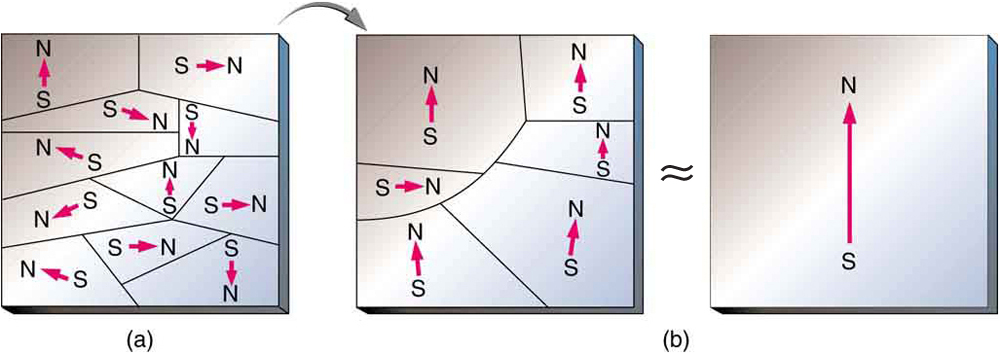
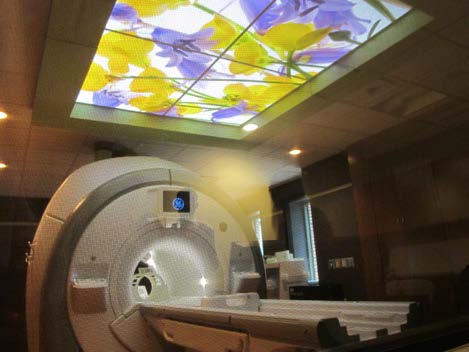
CHAPTER 22 | MAGNETISM 777
response to an external magnetic field, the domains may grow to millimeter size, aligning themselves as shown in Figure 22.8(b). This induced
magnetization can be made permanent if the material is heated and then cooled, or simply tapped in the presence of other magnets.
Figure 22.8 (a) An unmagnetized piece of iron (or other ferromagnetic material) has randomly oriented domains. (b) When magnetized by an external field, the domains show
greater alignment, and some grow at the expense of others. Individual atoms are aligned within domains; each atom acts like a tiny bar magnet.
Conversely, a permanent magnet can be demagnetized by hard blows or by heating it in the absence of another magnet. Increased thermal motion at
higher temperature can disrupt and randomize the orientation and the size of the domains. There is a well-defined temperature for ferromagnetic
materials, which is called the Curie temperature, above which they cannot be magnetized. The Curie temperature for iron is 1043 K (770ºC) ,
which is well above room temperature. There are several elements and alloys that have Curie temperatures much lower than room temperature and
are ferromagnetic only below those temperatures.
Electromagnets
Early in the 19th century, it was discovered that electrical currents cause magnetic effects. The first significant observation was by the Danish
scientist Hans Christian Oersted (1777–1851), who found that a compass needle was deflected by a current-carrying wire. This was the first
significant evidence that the movement of charges had any connection with magnets. Electromagnetism is the use of electric current to make
magnets. These temporarily induced magnets are called electromagnets. Electromagnets are employed for everything from a wrecking yard crane
that lifts scrapped cars to controlling the beam of a 90-km-circumference particle accelerator to the magnets in medical imaging machines (See
Figure 22.9).
Figure 22.9 Instrument for magnetic resonance imaging (MRI). The device uses a superconducting cylindrical coil for the main magnetic field. The patient goes into this
“tunnel” on the gurney. (credit: Bill McChesney, Flickr)
Figure 22.10 shows that the response of iron filings to a current-carrying coil and to a permanent bar magnet. The patterns are similar. In fact,
electromagnets and ferromagnets have the same basic characteristics—for example, they have north and south poles that cannot be separated and
for which like poles repel and unlike poles attract.
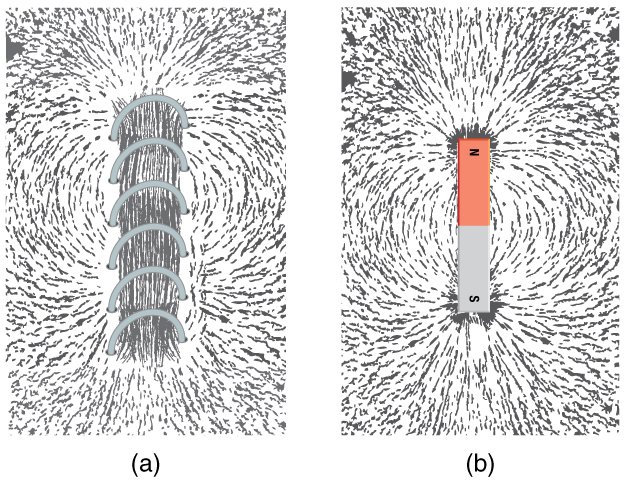
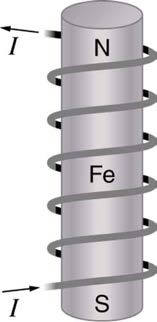
778 CHAPTER 22 | MAGNETISM
Figure 22.10 Iron filings near (a) a current-carrying coil and (b) a magnet act like tiny compass needles, showing the shape of their fields. Their response to a current-carrying coil and a permanent magnet is seen to be very similar, especially near the ends of the coil and the magnet.
Combining a ferromagnet with an electromagnet can produce particularly strong magnetic effects. (See Figure 22.11.) Whenever strong magnetic
effects are needed, such as lifting scrap metal, or in particle accelerators, electromagnets are enhanced by ferromagnetic materials. Limits to how
strong the magnets can be made are imposed by coil resistance (it will overheat and melt at sufficiently high current), and so superconducting
magnets may be employed. These are still limited, because superconducting properties are destroyed by too great a magnetic field.
Figure 22.11 An electromagnet with a ferromagnetic core can produce very strong magnetic effects. Alignment of domains in the core produces a magnet, the poles of which
are aligned with the electromagnet.
Figure 22.12 shows a few uses of combinations of electromagnets and ferromagnets. Ferromagnetic materials can act as memory devices, because
the orientation of the magnetic fields of small domains can be reversed or erased. Magnetic information storage on videotapes and computer hard
drives are among the most common applications. This property is vital in our digital world.
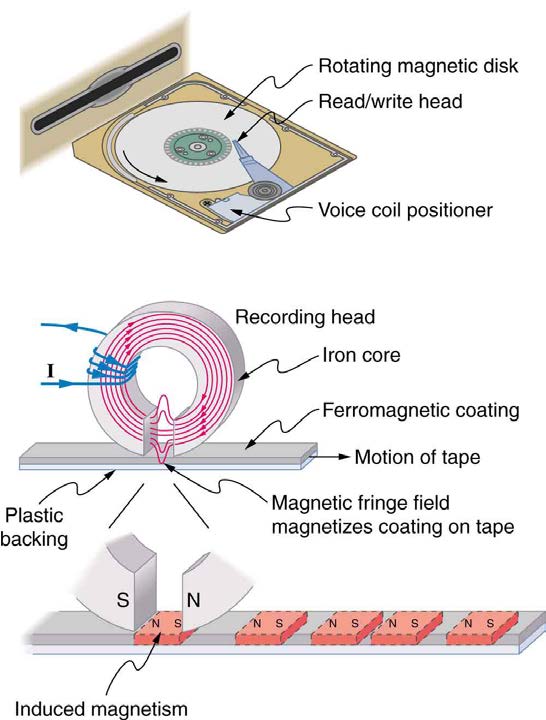
CHAPTER 22 | MAGNETISM 779
Figure 22.12 An electromagnet induces regions of permanent magnetism on a floppy disk coated with a ferromagnetic material. The information stored here is digital (a region
is either magnetic or not); in other applications, it can be analog (with a varying strength), such as on audiotapes.
Current: The Source of All Magnetism
An electromagnet creates magnetism with an electric current. In later sections we explore this more quantitatively, finding the strength and direction
of magnetic fields created by various currents. But what about ferromagnets? Figure 22.13 shows models of how electric currents create magnetism
at the submicroscopic level. (Note that we cannot directly observe the paths of individual electrons about atoms, and so a model or visual image,
consistent with all direct observations, is made. We can directly observe the electron’s orbital angular momentum, its spin momentum, and
subsequent magnetic moments, all of which are explained with electric-current-creating subatomic magnetism.) Currents, including those associated
with other submicroscopic particles like protons, allow us to explain ferromagnetism and all other magnetic effects. Ferromagnetism, for example,
results from an internal cooperative alignment of electron spins, possible in some materials but not in others.
Crucial to the statement that electric current is the source of all magnetism is the fact that it is impossible to separate north and south magnetic poles.
(This is far different from the case of positive and negative charges, which are easily separated.) A current loop always produces a magnetic
dipole—that is, a magnetic field that acts like a north pole and south pole pair. Since isolated north and south magnetic poles, called magnetic
monopoles, are not observed, currents are used to explain all magnetic effects. If magnetic monopoles did exist, then we would have to modify this
underlying connection that all magnetism is due to electrical current. There is no known reason that magnetic monopoles should not exist—they are
simply never observed—and so searches at the subnuclear level continue. If they do not exist, we would like to find out why not. If they do exist, we
would like to see evidence of them.
Electric Currents and Magnetism
Electric current is the source of all magnetism.
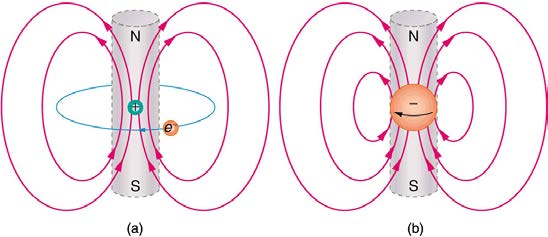

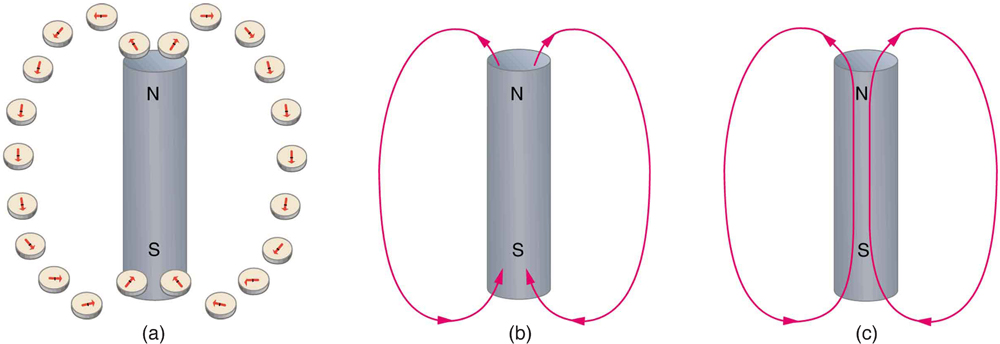
780 CHAPTER 22 | MAGNETISM
Figure 22.13 (a) In the planetary model of the atom, an electron orbits a nucleus, forming a closed-current loop and producing a magnetic field with a north pole and a south
pole. (b) Electrons have spin and can be crudely pictured as rotating charge, forming a current that produces a magnetic field with a north pole and a south pole. Neither the
planetary model nor the image of a spinning electron is completely consistent with modern physics. However, they do provide a useful way of understanding phenomena.
PhET Explorations: Magnets and Electromagnets
Explore the interactions between a compass and bar magnet. Discover how you can use a battery and wire to make a magnet! Can you make it
a stronger magnet? Can you make the magnetic field reverse?
Figure 22.14 Magnets and Electromagnets (http://cnx.org/content/m42368/1.3/magnets-and-electromagnets_en.jar)
22.3 Magnetic Fields and Magnetic Field Lines
Einstein is said to have been fascinated by a compass as a child, perhaps musing on how the needle felt a force without direct physical contact. His
ability to think deeply and clearly about action at a distance, particularly for gravitational, electric, and magnetic forces, later enabled him to create his
revolutionary theory of relativity. Since magnetic forces act at a distance, we define a magnetic field to represent magnetic forces. The pictorial
representation of magnetic field lines is very useful in visualizing the strength and direction of the magnetic field. As shown in Figure 22.15, the
direction of magnetic field lines is defined to be the direction in which the north end of a compass needle points. The magnetic field is traditionally
called the B-field.
Figure 22.15 Magnetic field lines are defined to have the direction that a small compass points when placed at a location. (a) If small compasses are used to map the
magnetic field around a bar magnet, they will point in the directions shown: away from the north pole of the magnet, toward the south


















